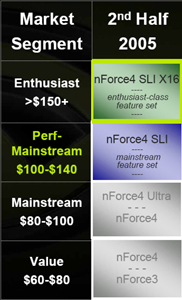nForce 4 SLI X16: Full Speed PCI Express
by Derek Wilson on August 8, 2005 1:56 PM EST- Posted in
- CPUs
Final Words
The first motherboards are only available from Dell, and other vendors will be bringing out products shortly. NVIDIA is shipping chips now, so it shouldn't be too long before we are able to buy an SLI X16 based board. Normally, we would lament the break in NVIDIA's recent trend of announcing a product with immediate broad availability, but if that's what it takes for NVIDIA to get a deal with Dell, then more power to them. Getting the SLI X16 into the new XPS 600 is quite a big deal for NVIDIA.NVIDIA is touting the added bandwidth as a performance increasing factor for the future. They acknowledge that current games don't see much benefit from the added bandwidth, but stand firmly behind the assertion that future games designed for PCI Express and SLI will take advantage of the increased bandwidth offered. We certainly aren't expecting to see any major gains under current titles, but we will have to wait until we get our hands on a board to play with before we can say for sure what we think of the performance.
We did take a couple of shots at comparing workstation class hardware to current nForce 4 SLI (nForce Professional enables 2 full x16 PCI Express connections with 2 processors), but due to the processor and memory configuration difference, we couldn't devise a fair test that could narrow down the impact of PCI Express bandwidth on real world games. Hopefully, we will have an SLI X16 board in our labs sooner rather than later.
There are no downsides to the convenience and market impact factors of this launch. On the high end, not having to flip a paddle is a welcome change. The added configuration options that motherboard makers will have for PCI Express slots can only help speed adoption. As motherboards based on the SLI X16 chipset will come in at current high end prices, the current SLI boards will fall in price and mainstream users will find little reason not to grab an SLI based system over the NF4 Ultra. More people with SLI systems means more impact from things like budget and mainstream GPUs supporting SLI. Here's the new price structure for NVIDIA based motherboards as NVIDIA sees it.

This is also a preemptive blow to ATI's Crossfire. With Crossfire motherboards not offering more than 2 x8 slots and many manufacturers going with the paddle design rather than ATI's recommended ICs for auto configuration, the new ATI enthusiast board will be stuck competing with a now mainstream product from NVIDIA. To be sure, the Crossfire motherboards are very good performers, but with this new option from NVIDIA and the price drop in current SLI products, ATI will have an even harder time getting their motherboards to end users.
We also see some possibilities for the GPGPU crowd with this addition of bandwidth to SLI configurations. This setup does more than just make it easier to move data around on each card. GPGPU stands for "General-Purpose Computation on Graphics Hardware" and with this setup, there is more than twice as much bandwidth dedicated to graphics as there is to system RAM in an AMD system with DDR 400. Depending on the latency, this opens up quite a number of possibilities for using the storage space available on graphics cards when they aren't in use. If some program (or even Windows itself) decided to treat unused graphics RAM as a separate memory node, we could see a total theoretical memory bandwidth of well over 20 GB/sec. Since system busses don't get guaranteed latencies, we would have to expect something like this to only benefit very high bandwidth stream processing. There was some talk at NVIDIA about GPGPU projects that they have under wraps, but they didn't give us any indication of what they are looking at doing right now.
In the end, even if performance impact isn't great (and even if NVIDIA's promised future performance benefits never materialize), this launch is a very good thing. Pushing prices on SLI systems down to more affordable levels and offering the potential for more PCI Express expansion slots (each with higer bandwidth) is definitely welcome. This is not the kind of solution that will entice current nForce4 SLI users to upgrade and the verdict is still out on whether or not there will be a real world performance difference, but the existance of the nForce4 SLI X16 solidifies NVIDIA's position in the core logic market and helps to push prices down across the board.










61 Comments
View All Comments
Schadenfroh - Monday, August 8, 2005 - link
#2, the question is there a graphics card which utilizes the features/speed advantage that PCI-E 8x offers over AGP 8X.